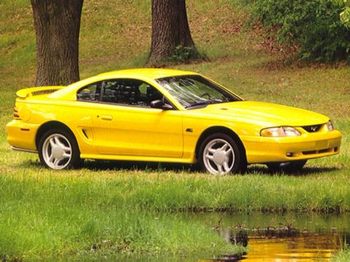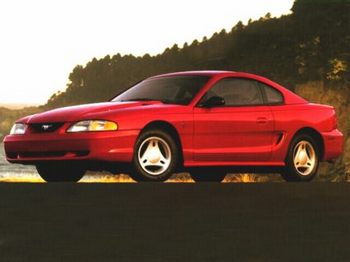1994-1998 Ford Mustang Post Fox Body Pre New Edge SN95 History: GT, Cobra, Engine, and Performance
After 15 years of the incredibly famous Fox Body Ford Mustang, some enthusiasts were happy to hear about an intended redesign, the 4th full redesign of the model’s existence. The Fox Body Mustang brought the model line back up from near ruin, caused by the 4 cylinder, low performance Mustang II, and emissions standards that hurt the performance of the classic Mustangs. Though some hoped for a redesign through several years of the Fox Body, the look should be credited with putting the Mustang back atop the pony car market once again, right where it belonged.

1994
Prior to its release, this new 1994 Ford Mustang was attributed
conceptual drawings showing a sort of futuristic form of the original,
but when it debuted the cues were shown to be hints at best. Dubbed the
SN95, this Mustang was far more aerodynamic than any before it, with
smooth, rounded lines completely unlike the Fox Body era. While some
people were unhappy with it, the new Mustang sold well and horsepower
was up across the board. In place of the anemic 105 horsepower 4-banger
was a new 3.8L offering 145 horsepower. The GT received a bump in power
up to 215, and, though the Cobra R was MIA in 1994, the Cobra was back
with 240 horsepower. The interior received some upgrades to add more
comfort to the model, as well; all of this translating to a rise in
cost. In order to help promote the new 1994 Mustang Cobra, they put it
in the public eye in a similar manner to that of the 1964 Mustang: lead
the field at the Indy 500. To commemorate this event, all of the 1000
1994 Ford Mustang Cobra convertibles were “Indy 500 Pace Car” editions.
While there was no Cobra R offered for the 1994 model year, late in the
1994 year Roush Performance offered a performance intake system, as
well as various suspension upgrades, and this Roush lineup would remain
the same throughout the run of the SN95 Mustang. While the Roush
offered a great handling and appearance package, the true Mustang
buying horsepower junkies had another option, as Saleen Industries
released the powerful new S-351 which offered 371 horsepower, and if
that was not enough, you could opt for the SR, which built an
impressive 480 horsepower, although the SR was very rare with only 2
being built. Overall, the redesigned Mustang was a success, selling
over 10,000 more units than the previous year.
1995
The 1995 Mustang brought about no significant changes to the base
model, GT, or Cobra, but the addition of two new trim lines offered
enthusiasts two quick new options. The first, more basic addition was
the Mustang GTS. The GTS was basically a stripped down GT, with the
performance aspects of the GT, as well as the badging, but there were
no fog lights as found on the GT, and no rear GT wing. Also, the
interior was similar to that found in the V6 base model with cloth
manual seats; although a power driver’s seat was an option. The GT
gauge cluster was standard on the GTS, but power locks and windows were
not. However, if you chose a GTS, you could order any option that was
offered for the base model. This trim line offered someone who wanted
the grunt of the GT without the cost and options, and this was only
offered for 1995. The bigger news was the reintroduction of the mighty
Cobra R. Considering the popularity of the 1993 Cobra R, the SVT
engineers went back to work to produce an even meaner R, and the 1995
Cobra R did not disappoint. While the 1993 Cobra R used the same engine
as the Cobra, the 1995 R used a whole new engine, and the 250 1995
Cobra R’s were basically a street legal race car, and a professional
driver’s license (NHRA or SCCA) was required for purchase. The new
engine of the Cobra R was a naturally aspirated 5.8L, producing 300
horsepower, mated to a Tremec 5-speed manual transmission, and fed by a
20 gallon Fuel-Safe racing fuel cell. The suspension was heavily
upgraded with progressive rate springs, a front strut tower brace, and
larger stabilizer bars; so not only would this new Cobra R get up and
go in a straight line (running a stock 13.8 second quarter mile) but it
would also handle the road course as well. Saleen Industries had the
relative same lineup, with the power ranging from 371 to 480
horsepower. One other interesting and very rare Mustang offering for
1995 was the option of a hardtop convertible. 499 of this hardtop
convertible were produced, and even more rare were a few convertibles
which came with a hardtop and soft-top, and although they were never
officially offered, there are some in public hands today. The hardtop
option was cool, but it was inconvenient and would be done away with
after 1995. Thanks in part to the new options, and the increased
interest of the public the 1995 outsold the 1994 model.
1996
When the 1996 Mustang debuted, it appeared to be the same as the
previous year, but there were big changes under the hood. The famed 5
Liter engine, having been used since the years of the Mustang II, was
gone, having been replaced with a new 4.6L engine which used an
overhead cam (OHC) design. The base model V6 Mustangs, with the same
3.8L engine, got an increase in power, up to 150 horsepower. The entire
model line received new tail lights in 1996, with three vertical lights
separated by a body colored trim piece, and these new tails resembled
the original Mustang; at least about as well as the other “1964 cues”
did so. While the GT did not receive a jump in power with the new
engine, the Cobra went from 240 horsepower with the 5.0L engine to 305
horsepower with the new Dual Overhead Cam (DOHC) 4.6L engine. The Cobra
was offered in Black, Laser Red, Crystal White, and Mystic. Mystic was
by far the most intriguing (and most expensive) of the offered colors,
and depending on the amount and angle of light, the different angles of
the car would appear to be purple, green, or bronze. The GTs were not
left out of the “special paint” department, and 829 bright Tangerine
GTs were produced in 1996. Saleen also introduced a new model, with the
S-281. This was a much lower performing Mustang than was the S-351, and
was far more affordable. The S-351 power hiked up to 495, but
production dropped to just 20, although the overall sales of the Saleen
(thanks mostly to the lower cost of the S-281) to over 440 units, where
the 1995 Saleen only saw about 133 units. Overall, production of the
Ford Mustang dropped a bit from 1995.
1997
This was a fairly uneventful year for the Mustang. There were no
changes made to the V6 base model, or the Cobra (shy of the lack of the
Mystic paint), but the GT received a standard revamped alarm system as
well as a new standard fabric. Much like the standard models, the
Saleen models remained the same, with the S-281 and S-351 being offered
with the same performance ratings, however production of the S-351 went
up a bit, and the production of the S-281 went down. Overall sales of
the Mustang went down in 1997, with sales drooping to around 108,000;
the lowest since 1992.
1998
1998 would mark the final year of the SN95, and evidently the news of
the SN95 coming to an end brought about a sales rush, as sales numbers
jumped from around 108,000 to almost 176,000. This was surprising
considering the relatively poor sales of 1997, and also considering the
fact that nothing had changed from the 1997 model to the 1998 model,
except for the deletion of the dash clock, but it can be assumed that
an extra 69,000 people bought a 1998 Mustang because they didn’t like
how the clock looked. The Saleen models were once again the same as the
previous year with the S-281 and S-351, but to commemorate the 15th
anniversary of the Saleen Mustang, the SA-15 was offered. The SA-15 was
a dressed up S-281, and was very rare, with only 10 produced, and those
10 are easy to recognize due to their bright yellow paint and wheels.
The following year would bring about another redesign of the Mustang,
and while at the time the SN95 was considered to be a nice change from
the fairly boxy Fox Body Mustangs, the SN95s are considered to be less
desirable than the Fox Body Mustang, as they are more powerful, but are
heavier, resulting in a slower car in many cases. This generation was
one of the most popular for special editions, and those special models
are still well sought after, but for many, the SN95 was another dark
time for Mustang enthusiasts, second only to the Mustang II. But all in
all, the SN95 was a successful generation, and are still popular among
performance minded enthusiasts, thanks in part to the wide variety of
upgrades available for them.
Want a whole lot more discussion on the SN95 era? Find it here!
